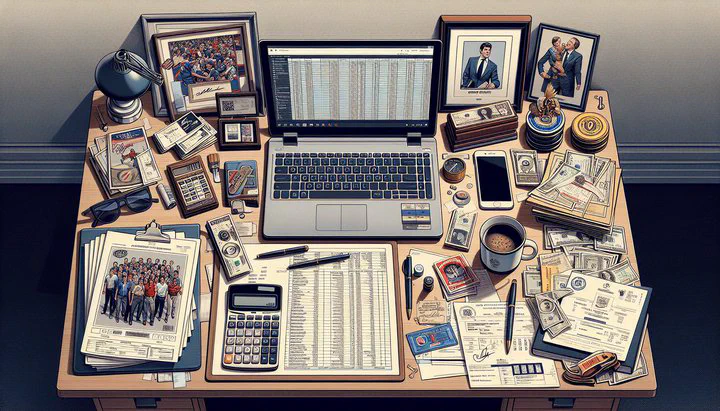Deduct Cost of an Item for Taxes

How to Deduct the Cost of an Item for Taxes: A Guide for Collectors and Sellers
Are you a collector or online seller puzzled by the intricacies of tax deductions? You’re not alone! With this guide, you’ll learn how to navigate tax deductions and keep more of your hard-earned money.
Understanding Tax Deductions for Collectibles
Navigating taxes can be tricky, especially when you’re a collector or online seller dealing with unique items. Tax deductions are crucial because they help lower the amount of income that’s taxed, saving you money. For collectors and sellers, understanding how to deduct the cost of an item for taxes is an important part of managing your business.
So, what can you deduct? As an online seller in the collectibles market, you can deduct costs related to buying and selling your items. This includes the purchase price of collectibles, shipping fees, and even the cost of packing materials. If you use e-commerce platforms like eBay, the fees they charge can also be deducted. These deductions reduce your taxable income, meaning you pay less tax overall.
Let’s look at some examples:
- Buying and Selling: Suppose you bought a rare trading card for $100 and later sold it for $150. You can deduct the original $100 purchase cost from your income.
- Shipping Costs: If you paid $10 for shipping when you sold the card, that’s deductible too.
These deductions are not just about saving money—they help you keep accurate financial records and understand the true profit from your sales. By knowing what you can deduct, you can answer questions on cost, income, and taxes more confidently. Stay organized, keep records of every expense, and you’ll find that managing taxes becomes a much smoother process.
Your Easy Step-by-Step Guide
Now that you know the basics, let’s dive into a step-by-step guide on how to deduct the cost of an item for taxes. This guide is tailored for you, the collector or online seller, to help make the process as smooth as possible.
Step 1: Keep Detailed Records
Make sure you keep clear records of every purchase and sale. This includes receipts, invoices, and any other documents that show how much you paid or earned. For example, if you buy a sports memorabilia item, save the receipt and any shipping documents. These records are your proof when you deduct the cost of an item for taxes.
Step 2: Track Your Expenses
Next, track all related expenses. This means noting down things like shipping costs, eBay fees, and even expenses for packing materials. Keeping a spreadsheet or using accounting software can help you stay on top of these expenses. This step is crucial because these are the expenses you’ll claim when you deduct costs.
Step 3: Understand Reporting Requirements
When tax time comes, you’ll need to report your deductions accurately. As an online seller, you’ll likely need to fill out a Schedule C form if you’re in the U.S. This form helps you report your income and expenses. Make sure you record each item correctly to avoid any issues. If you’re unsure about any part of the form, consulting with a tax professional can be a wise move.
Step 4: Avoid Common Pitfalls
One common pitfall is forgetting to deduct small expenses that add up, like packing tape or small eBay fees. Another is not keeping digital copies of receipts, which can be lost easily if they’re only on paper. Stay vigilant and ensure you have digital backups for all your records.
By following these steps, you can confidently approach tax season, knowing exactly how to deal with the taxes smoothly. Keeping organized records and understanding the reporting process will help you answer common questions on cost, income, and taxes. Remember, the key to successfully deducting item costs is being thorough and organized with your records.
Dealing with Tax Challenges and FAQs
Even when you understand the basics and follow a step-by-step process, dealing with taxes can still be challenging. Many online sellers and collectors have common questions on cost, income, and taxes, especially when trying to deduct the cost of an item for taxes. Let’s address some of these questions and how to tackle them effectively.
FAQ 1: How do you deduct the cost of an item for taxes if you don’t have a receipt?
If you’ve lost a receipt, don’t panic. You can still deduct costs by providing other proof of purchase. Bank or credit card statements that show the transaction can be useful. It’s always a good idea to back up your receipts digitally as a precaution.
FAQ 2: What if I get audited?
Audits can be daunting, but they’re manageable if you’re prepared. The key is having organized records. If you’ve followed the steps to keep detailed records and track expenses, you will have the documents needed to support your deductions. An audit isn’t necessarily a problem if you can prove your claims.
FAQ 3: What should I do if I made a mistake on my taxes?
Mistakes happen, but they’re fixable. If you realize there’s an error after you’ve filed, you can amend your tax return. This might involve filling out additional forms, like Form 1040X in the U.S. It’s best to correct mistakes as soon as you find them to avoid penalties.
Understanding and Staying Informed
Tax laws can change, so it’s important to stay updated on any new rules that might affect how you deduct the cost of an item for taxes. Joining communities, like relevant subreddits or forums, can keep you informed and provide support from fellow sellers.
By addressing these challenges and understanding the answers to frequently asked questions, you’ll be better equipped to handle tax season. Remember, the goal is to stay organized, informed, and proactive. This way, you can confidently manage your taxes and focus on what you love—collecting and selling amazing items!
By mastering the art of tax deductions, you can focus on what you love—finding and selling amazing collectibles!